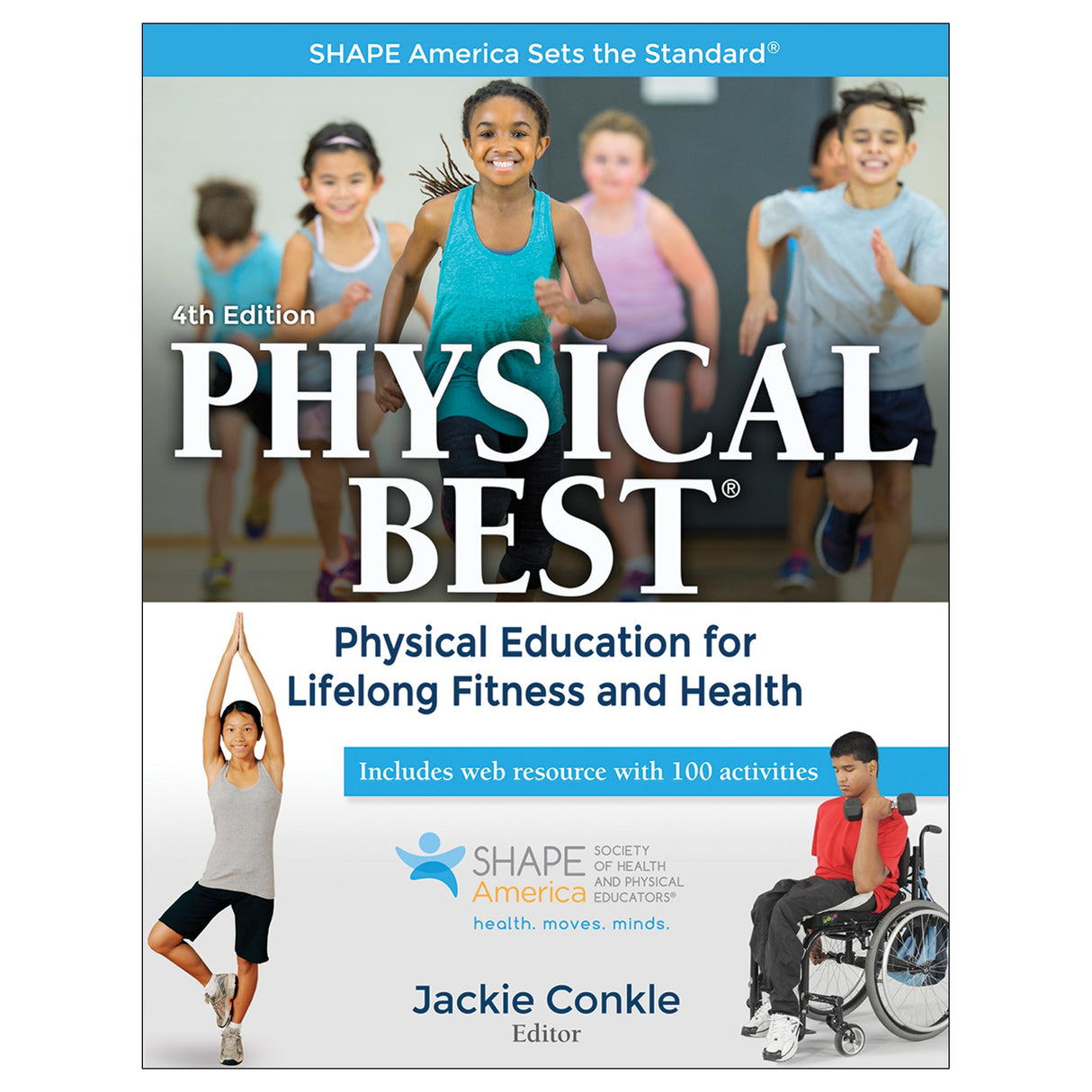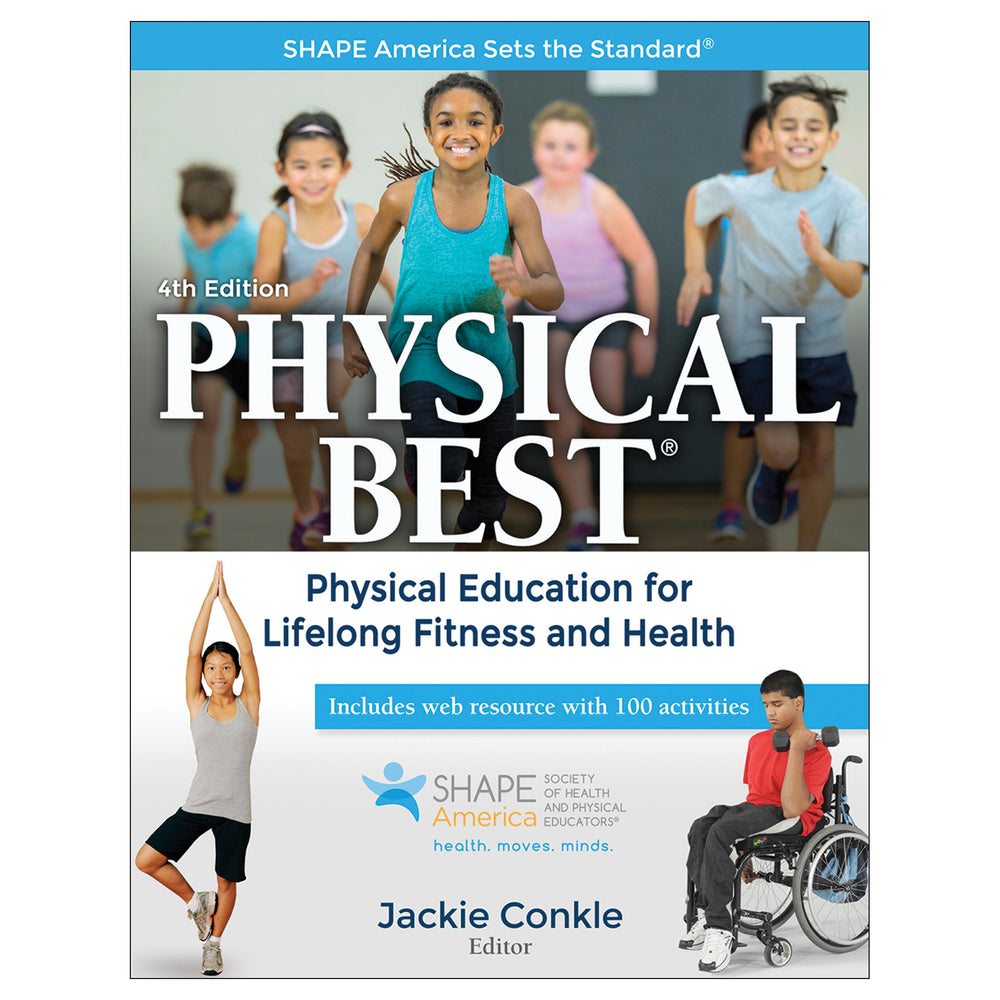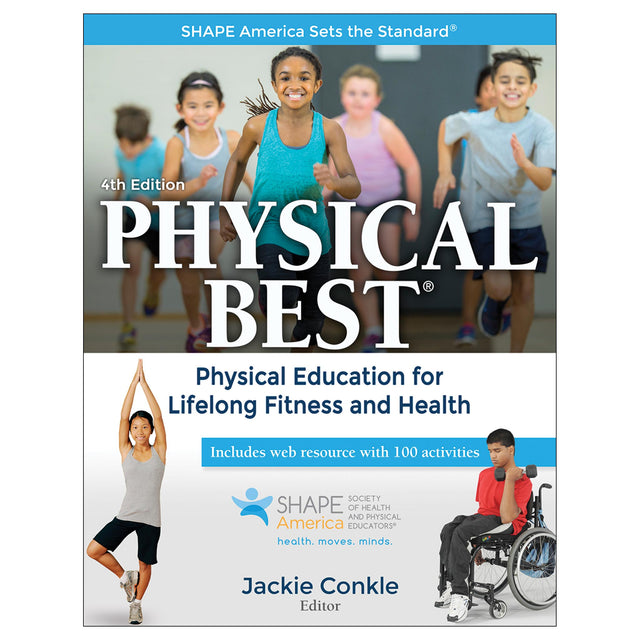Physical Best 4th Edition epub With Web Resource
Physical Education for Lifelong Fitness and Health
Author: Jackie Conkle
$79.95 CAD
Access Duration: 10 Years
Physical Best, developed by experts identified by SHAPE America, has long been the standard in the field for health-related fitness education, and this latest rendition is the best and most complete package yet:
- A comprehensive, three-in-one resource. The entire Physical Best program was previously spread over three books (Physical Education for Lifelong Fitness, Physical Best Activity Guide—Elementary Level, and Physical Best Activity Guide—Middle and High School Levels). It now is offered in one all-inclusive resource to reinforce the scope and sequence of the program so teachers can see what comes before and after the grade levels they teach.
- Updated material to address standards. All chapters and activities are updated to address SHAPE America’s National Standards and Grade-Level Outcomes for K-12 Physical Education. Teachers can be confident they are measuring student progress effectively.
- New or revised chapters. Teachers will benefit from the new information on the latest research, technology, power training, professional development, best practices, and more.
- An attractive four-color layout. The text now features four-color illustrations.
- A web resource that includes K-12 activities. With previous editions, the activities were housed in two separate books, one for elementary teachers and one for middle and secondary teachers. Now, all activities are on the accompanying web resource, where teachers can sort the activities by standard, grade, outcome, and skill and then use them on a mobile device or download and print them. Most activities are supported by ready-to-use reproducible forms such as handouts, assessments, posters, and worksheets.
Physical Best meets needs on many levels. For veteran teachers, it outlines strategies for emphasizing health-related fitness in their existing programs. New teachers will benefit from the specific examples from master teachers and be able to use this guidance for creating an effective fitness education program. For teacher education programs, it provides an overview of current research, trends, and best practices in health-related fitness. And for district coordinators, it reinforces professional development training and continued education.
Physical Best helps teachers impart the skills and knowledge that students need to become physically literate—the first step to leading healthier, less stressful, and more productive lives. It details best practices, provides current content, and shows how to integrate health-related fitness education into an existing curriculum. It helps students meet standards and grade-level outcomes. It can help spark student interest in lifelong physical activity. And it will help teachers be the best physical educators they can be as they shape the future health of the nation.
Human Kinetics is proud to publish this book in association with SHAPE America, the national organization that defines excellence for school-based health and physical education professionals across the United States.
Audience
Undergraduate text for preservice physical educators. Resource for K-12 physical educators and program coordinators.Suzan F. Ayers and Mary Jo Sariscsany
What Is the Physical Best Instructional Approach?
Health-Related Fitness Education
What Makes Physical Best Unique?
Physical Best Activities
Related Resources
Physical Best Certificate
Summary
Discussion Questions
Chapter 2. Creating Physical Activity Behaviors That Last a Lifetime
Hannah Brewer, Ethan Hull, and Randy Nichols
Physical Activity Trends
Physical Activity and Behavior Change
Motivation
Comprehensive School Physical Activity Programs (CSPAPs)
Goal Setting
Summary
Discussion Questions
Chapter 3. Basic Training Principles
Sean Bulger and Brooke Towner
Understanding the Basic Training Principles
Applying the Basic Training Principles
Components of a Physical Activity Session
Social Support and Safety Guidelines
Summary
Discussion Questions
Chapter 4. Exploring Nutrition for Student Health
D. Gayle Povis
Healthy Students Do Better in School
Road Map to Healthy Eating
Carbohydrate, Protein, and Fat (Macronutrients)
Energy From Food Fuels Activity
Making Sense of Food Labels
Vitamins and Minerals (Micronutrients)
Water for Health and Performance
Beware of Added Sugar and Sodium
Creating a Culture of Health
Summary
Discussion Questions
Chapter 5. Cardiorespiratory Endurance
Jan Galen Bishop and Bette Jean Santos
Cardiorespiratory Endurance and Related Terms
Importance and Benefits of Cardiorespiratory Endurance
Physical Activity and Cardiorespiratory Endurance Guidelines
Teaching Cardiorespiratory Endurance
Principles of Exercise and Cardiorespiratory Endurance
Monitoring Intensity
Training Methods for Cardiorespiratory Endurance
Safety Guidelines
Technology
Assessing Cardiorespiratory Endurance
Cardiorespiratory Endurance and the Curriculum
Summary
Discussion Questions
Chapter 6. Body Composition
Scott Going and Melanie Hingle
Teaching Guidelines for Body Composition
Strength Training and Body Composition Management
Methods of Measuring Body Composition
Helping Students Who Are Overfat or Underfat
Summary
Discussion Questions
Chapter 7. Flexibility
Elizabeth A. Burkhart and Philip Dlugolecki
Definitions of Flexibility Concepts
Types of Stretching
Benefits of Flexibility
Factors Affecting Flexibility
Teaching Guidelines for Flexibility
Yoga in Physical Education
Principles of Training
Addressing Motor Skills Through Flexibility Activities
Safety Guidelines for Flexibility Activities
Contraindicated Exercises
Summary
Discussion Questions
Chapter 8. Muscular Strength and Endurance
Patrick McHenry
Definitions of Muscular Strength and Endurance Concepts
Developmentally Appropriate Resistance Training
Benefits of Resistance Training
Teaching Guidelines for Muscular Strength and Endurance
Principles of Training
Training Methods for Muscular Strength and Endurance
Alternative Methods of Training
Addressing Motor Skills Through Muscular Strength and Endurance Activities
Safety Guidelines for Muscular Strength and Endurance Activities
Summary
Discussion Questions
Chapter 9. Integrating Health-Related Fitness Education Into the Curriculum
Bane McCracken
Curriculum Development
Physical Education Curriculum Analysis Tool (PECAT)
Program Design
Developing Objectives and Outcomes
Developing a Curriculum to Promote Lifetime Health-Related Fitness
Teaching for Lifelong Fitness
Fitness Education Cycle
Student Choice
Fitness for Life
Summary
Discussion Questions
Chapter 10. Employing Best Practices for Teaching
Betsy Gunther
Preparing the Environment
Keeping Students Involved
Teaching Styles
Enhancing Health-Related Fitness Education in the Classroom
The Concept of Homework
Extending Physical Activity Time
Technology
Summary
Discussion Questions
Chapter 11. Including Everyone
Keith Johannes, Brian Culp, and David Lorenzi
Relevant Laws
Benefits of Inclusion
Methods of Inclusion
Major Areas in Which to Ensure Inclusion
Summary
Discussion Questions
Chapter 12. Overview of Assessment and Assessing the Cognitive and Affective Domains
Christina Sinclair
Understanding Assessment
Importance of Assessment
Recommended Assessment Tools
Applying Assessment Tools
Using Assessments for Program Planning
Motivating Through Assessment
Making Assessment Practical
Summary
Discussion Questions
Chapter 13. Assessing Health-Related Fitness and Physical Activity
Lynn V. Johnson and Christina Sinclair
FitnessGram
Guidelines for Assessing Health-Related Fitness
Tailoring Health-Related Fitness Assessment
Using Health-Related Fitness Results Appropriately
Guidelines for Assessing Physical Activity
Tools for Assessing Physical Activity
Summary
Discussion Questions
Keeping Students Emotionally Safe
Social-Emotional Learning (SEL)
The Concept of Homework
What Makes Physical Best Unique?
Instructor Guide. Features include course outlines, syllabuses, activities, and other learning tools that will help new and experienced teachers deliver lessons that adhere to the Physical Best philosophy.
Test Package. Includes multiple-choice, true-or-false, fill-in-the-blank, and short-answer questions that make it easy to create quizzes and tests for students.
Presentation Package. Includes slides of key points and graphics from the book.
Web Resource. Includes more than 100 activities that can be sorted by standard, grade, outcome, and skill. Teacher can use them on a mobile device or download and print them.
Human Kinetics is pleased to partner with SHAPE America by offering discounts on our resources to SHAPE America members! Whether you’re a preK-12 teacher, higher education faculty member, researcher, administrator, or future professional, we’re here to help you in your professional career and personal fitness journey of improved fitness, stronger athletic performance, and better nutrition.
SHAPE America members receive a 30% discount on this resource and other eligible resources through the member portal at SHAPE America. Learn more about SHAPE America membership at SHAPEAmerica.org or direct your questions about the discount to askmembership@shapeamerica.org.





